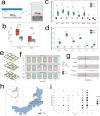Ectoparasites enhance survival by suppressing host exploration and limiting dispersal
- PMID: 40346081
- PMCID: PMC12064801
- DOI: 10.1038/s41467-025-59601-9
Ectoparasites enhance survival by suppressing host exploration and limiting dispersal
Abstract
Parasites enhance their fitness by manipulating host dispersal. However, the strategies used by ectoparasites to influence host movement and the underlying mechanisms remain poorly understood. Here, we show that ectoparasites alter metabolic activity in specific brain regions of mice, with evidence pointing to a potential role for microglial activation in the prefrontal cortex. This activation appears to contribute to synaptic changes and altered neuronal differentiation, particularly in GABAergic neurons. Consequently, exploratory behavior decreases-an effect likely mediated through the skin-brain axis. In both indoor and field experiments with striped hamsters, ectoparasites reduce host exploration and modify their dispersal patterns. This behavioral shift ultimately restricts the host's distribution, enabling parasites to avoid environmental pressures. Our findings reveal that ectoparasites limit host dispersal to improve their own fitness, offering key insights for parasite control strategies that promote health and preserve ecological stability within the One Health framework.
© 2025. The Author(s).
Conflict of interest statement
Competing interests: The authors declare no competing interests.
Figures









Similar articles
-
Parasitism Risk and Infection Alter Host Dispersal.Am Nat. 2020 Aug;196(2):119-131. doi: 10.1086/709163. Epub 2020 Jun 10. Am Nat. 2020. PMID: 32673087
-
Systemic LPS-induced microglial activation results in increased GABAergic tone: A mechanism of protection against neuroinflammation in the medial prefrontal cortex in mice.Brain Behav Immun. 2022 Jan;99:53-69. doi: 10.1016/j.bbi.2021.09.017. Epub 2021 Sep 25. Brain Behav Immun. 2022. PMID: 34582995
-
Repeated Activation of Pyramidal Neurons in the Prefrontal Cortex Alters Microglial Phenotype in Male Mice.J Pharmacol Exp Ther. 2024 Jan 17;388(2):715-723. doi: 10.1124/jpet.123.001759. J Pharmacol Exp Ther. 2024. PMID: 38129124 Free PMC article.
-
Host dispersal as the driver of parasite genetic structure: a paradigm lost?Ecol Lett. 2016 Mar;19(3):336-47. doi: 10.1111/ele.12564. Epub 2016 Jan 5. Ecol Lett. 2016. PMID: 26843399 Review.
-
Modulating the modulators: parasites, neuromodulators and host behavioral change.Brain Behav Evol. 2002;60(6):370-7. doi: 10.1159/000067790. Brain Behav Evol. 2002. PMID: 12563169 Review.
References
-
- Altizer, S., Bartel, R. & Han, B. A. Animal migration and infectious disease risk. Science331, 296–302 (2011). - PubMed
-
- Poulin, R. & de Angeli, D. D. Animal migrations and parasitism: reciprocal effects within a unified framework. Biol. Rev. Camb. Philos. Soc.96, 1331–1348 (2021). - PubMed
-
- Balling, T. E. & Pfeiffer, W. Location‐dependent infection of fish parasites in Lake Constance. J. Fish. Biol.51, 1025–1032 (1997).
-
- Aprahamian, M. W. The effect of the migration of Alosa fallax fallax (Laécpède) into fresh water, on branchial and gut parasites. J. Fish. Biol.27, 521–532 (1985).
MeSH terms
Grants and funding
LinkOut - more resources
Full Text Sources

